Texas Railroad History - Tower 91 - West Point
A Crossing of the Missouri, Kansas & Texas Railway and the
San Antonio & Aransas Pass Railway
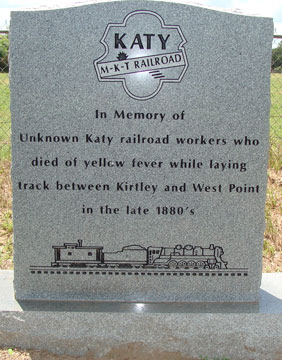
Left:
This marker stands in the Woods Prairie Cemetery near West Point memorializing
the Katy railroad workers who died of yellow fever in 1887 during construction
of the Missouri, Kansas & Texas (MK&T, "Katy") rail line between Taylor and La
Grange. According to an article in Footprints of
Fayette County (with this uncredited photo) written by two railroad engineers, Larry Lutringer and
W. O. Wood, the marker was...
...placed
there by Bobbie Robbins Stevens in 2013 and paid for by her mother, Susan Grace
Young Robbins. Susan had heard the story of the railroad workers all her life
and had helped her Aunt Molly (Mrs. Charles Young) tend the graves when she was
a child. It was Charles Young and his brother Zed (Bobbie Robbins Stevens'
grandfather) who gave the railroad foreman permission to bury the men in the
cemetery. The railroad workers who died earlier were buried in a field next to
the railroad tracks near Primm, which was later renamed Kirtley.
The yellow fever epidemic that killed the Katy railroad workers was small in
comparison to the epidemic that had occurred in nearby La Grange twenty years
earlier which
killed at least 20% of the town's population. The fatality rate was 90% for
those infected. The
New Orleans Crescent of September 26, 1867
described the devastation...
"Those remaining of the citizens number barely 500 yet the interments have
reached as high as 24 in two days. ... Every house in the town is filled with
sickness and with death. Business has ceased entirely; the newspapers are no
longer published; the jail has been emptied of its inmates, who fled in terror
from the scene of desolation. In some cases there is no one to bury the
dead. Whole families have been swept away. ... The stores are all closed, and to
crown the misery of the unfortunate inhabitants, starvation is staring them in
the face. ...there were no provisions to be had in the town — not
even corn meal to make gruel with."
According to Fayette County sources, West Point was
founded by William Young in 1840 and named after his hometown, West Point,
Mississippi. This was long before two railroads came through the area in 1887,
the first being the Taylor, Bastrop & Houston (TB&H) Railway. West Point's
location roughly midway between Smithville and La Grange placed it in the middle
of a TB&H track segment that was part of 79 miles
built between Taylor and La Grange that year. The tracks actually terminated eleven miles beyond
La Grange at Boggy Tank, a name given to the end of track as there was nothing
else there. Why did construction stop? As was often the case for Texas railroads
in the post Civil War era, financial and legal issues halted the work.
The TB&H had been sponsored by the Missouri Pacific (MP) Railroad which was
controlled by notorious rail baron Jay Gould. Gould also controlled the
Missouri, Kansas & Texas (MK&T, "Katy") Railroad and its multistate route network that included tracks in Texas from the
Red River south through Fort Worth,
Waco and Temple. At
the time, the Katy was leased to MP and publicly, the
construction south from Fort Worth was viewed as a MP project all the way. The track ownership,
however, was formally assigned to the Katy because MP was a "foreign"
railroad; it could not comply with Texas law requiring railroads in Texas to be
headquartered in state. It could, however, operate in Texas using a Texas-based
subsidiary or lease. The Katy lease served this purpose and also gave Gould some
measure of protection against Katy stockholders. Gould's control of the Katy was
tenuous -- he owned very little of its stock and he had been elected its President by allies he had managed to infiltrate onto its Board of
Directors. The lease enabled Gould to transfer Katy profits to MP where he had
more substantial ownership, keeping the Katy's finances break even at best, to
the detriment of its stockholders. Gould's intent was to complete a route from
Fort Worth to Houston under MP control, and by the end of 1882, tracks had
reached as far south as
Taylor.
The end of track remained at Taylor for a time due to the
political climate in the Texas Legislature. In 1882, it had repealed the land
grant law and lowered authorized passenger fares, and additional railroad
regulations were still under consideration. By 1886, Gould was ready to proceed
and he directed MP to resume construction south out of Taylor. They did so by
soliciting a state charter for the Bastrop & Taylor Railway. Work commenced in
1887 under a revised name, the Taylor, Bastrop & Houston Railway. After passing
through Bastrop and crossing the Colorado River, the route took a southeast
heading into Smithville and then passed through West Point as it continued east
through La Grange toward Houston. A
branch out of Smithville was initiated toward San
Marcos from which the Katy planned to build a line to
San Antonio. Once
again, the effort was publicly a MP project, but the construction company had
been hired by the Katy. Upon completion, the Katy would acquire the TB&H and own
the route for MP's benefit. At least, that was the plan.
By late 1887, financial issues
had begun to mount for Gould as one of his Midwest railroads went bankrupt.
Meanwhile, legal issues in Texas began in December when another Gould railroad in
Texas, the International & Great Northern, was sued by the Texas Attorney
General alleging unlawful ownership. Work on the TB&H stopped immediately,
eleven miles east of La Grange, a site christened Boggy Tank.
By the time construction resumed in 1892, the TB&H had been acquired by the Katy
and the Katy had become
independent, no longer leased to MP and completely free of Gould's control. The Katy
continued eastward from Boggy Tank and reached Houston in 1893.
Where Was Boggy Tank?
29 55 N, 96 35 W
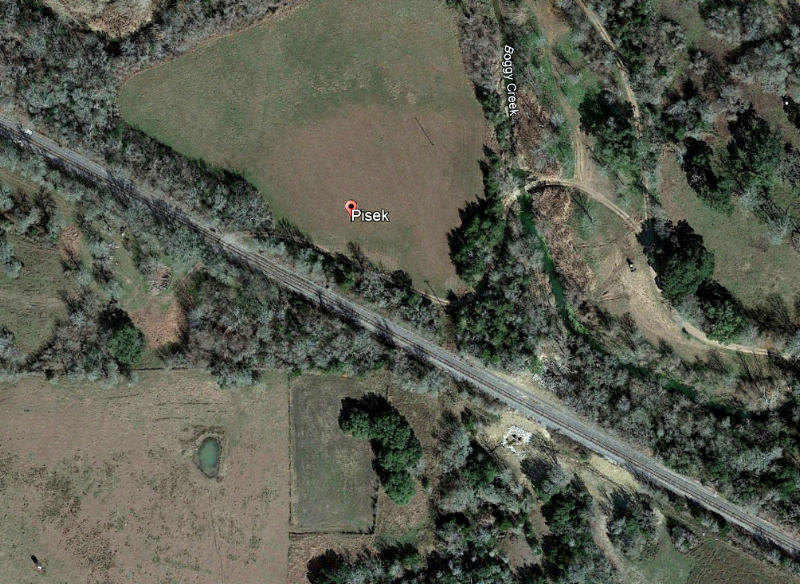 |
Left:
Referring to Boggy Creek, the Handbook of
Texas states that "Boggy Tank was a swampy area that gave the
creek its current name. The railroad built a turntable there to reverse
trains for the run back up the track. The town of Pisek ... moved one
mile to the tracks. The railroad called the site Sandy Point, but the
name Pisek stuck. By 1896 the community became a shipping center and had
a post office and saloon..." The Post Office closed in 1907. Since the turntable has been
gone for perhaps 130 years, it is not surprising that no visual evidence
of it remains in current satellite imagery. Nearby, however, is ...
something curious ... (below)
which only appeared within the past two years. (Google Earth, Jan. 2022)
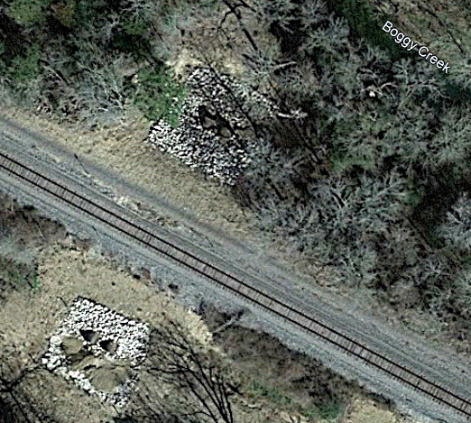 |
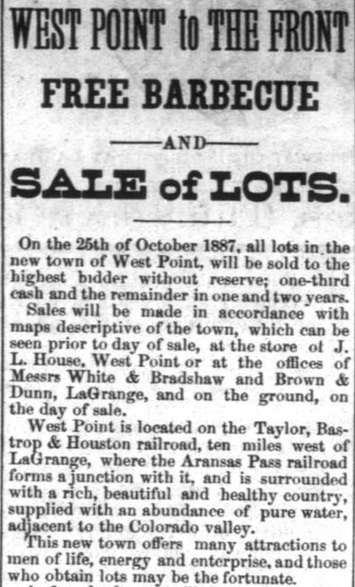 Left:
Although West Point had existed as a community since 1840, it was merely a rural
outpost with a handful of families at best, hence the arrival of the railroads in 1887
brought big changes. According to the La Grange
Journal, TB&H trains began operating through West Point in October.
The San Antonio & Aransas Pass (SA&AP) Railway, building northward
toward Waco, was about a month behind,
with trains anticipated into West Point by November 25. (Definitive dates of first trains into
West Point has not been found for either railroad.) The expected arrival of two
railroads into West Point within the span of a month or two spurred the real
estate promoters into action. The
La Grange Journal of October 6, 1887
carried this advertisement (which it listed in its "New Ads" column) announcing
that all lots in West Point would be sold on October 25th to the highest bidder.
And who among Texans can resist free barbecue?
Left:
Although West Point had existed as a community since 1840, it was merely a rural
outpost with a handful of families at best, hence the arrival of the railroads in 1887
brought big changes. According to the La Grange
Journal, TB&H trains began operating through West Point in October.
The San Antonio & Aransas Pass (SA&AP) Railway, building northward
toward Waco, was about a month behind,
with trains anticipated into West Point by November 25. (Definitive dates of first trains into
West Point has not been found for either railroad.) The expected arrival of two
railroads into West Point within the span of a month or two spurred the real
estate promoters into action. The
La Grange Journal of October 6, 1887
carried this advertisement (which it listed in its "New Ads" column) announcing
that all lots in West Point would be sold on October 25th to the highest bidder.
And who among Texans can resist free barbecue?
The ad uses the present tense to assert that the "...Aransas Pass forms a
junction..." with the TB&H. This was probably accurate as work trains would most
likely have reached West Point by October. This was somewhat amazing progress
for the SA≈ it had completed its
initial main line between San Antonio and
Corpus Christi a year earlier and then
promptly embarked on a massive construction program for 1887. One of the new lines
branched off the main at Kenedy and built as far as Wallis that year, eventually
to reach Houston. A branch from the Wallis line went north toward
Waco. It reached West Point in late November, where
northward construction stopped.
The south Texas branch point for the Waco line
was the new town of Yoakum, named for Benjamin Franklin Yoakum, a young
Texan hired by SA&AP President Uriah Lott as a clerk in 1886.
Within a year, Yoakum had risen
to the position of Traffic Manager at the time Lott named the town for him, and
he was soon the General Manager of the SA&AP. He subsequently became its
Receiver when it entered bankruptcy in 1890. When the bankruptcy was settled in
1892, Yoakum moved on to become a Vice President of the Gulf,
Colorado & Santa Fe Railway. In 1897, he moved again, to become General
Manager of the St. Louis San Francisco ("Frisco") Railway in St. Louis. He
eventually became the Chairman of the Board of the Frisco while simultaneously
leading the Executive Committee of the Board of Directors of the Chicago, Rock
Island & Pacific Railroad. In his spare time, Yoakum was a Director of the Colorado & Southern
Railroad. When he chartered the St. Louis, Brownsville & Mexico (SLB&M) Railway
on June 6, 1903 as a
Frisco-managed railroad that would connect the national rail network with the
Rio Grande Valley at Brownsville, he hired his former boss, Uriah Lott, to build
it and be its
President.
Having reached West Point, the SA&AP's northward construction
toward Waco stopped
while a major bridge over the Colorado River two miles north of West Point was
contemplated. The river was bridged in 1889 and the line was extended north
to Lexington that year. A track segment from Waco south to Lott was also completed in 1889.
The SA&AP's receivership commenced in the summer of 1890, and the final 58
mile segment between Lexington and Lott was completed during its bankruptcy in 1891.
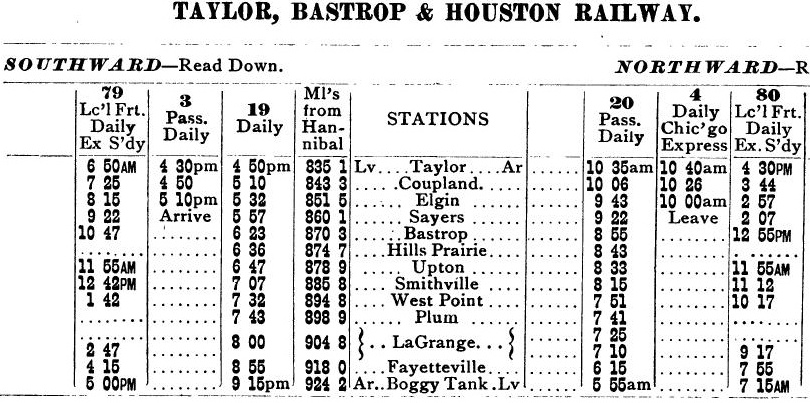
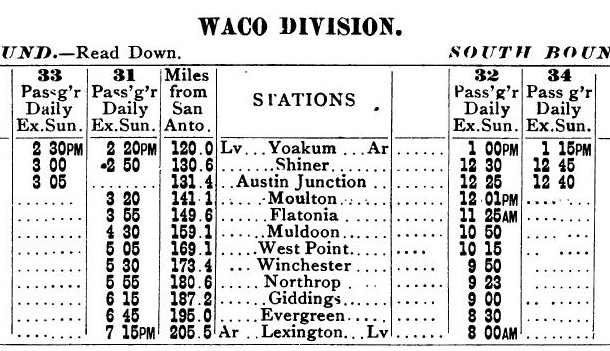
Above:
The Texas Spring Palace, a marketing pamphlet
published in 1890 to proclaim the virtues of Texas living for new settlers included a set of railroad timetables
for the entire state. These two timetables show the scheduled passenger service
through West Point for the TB&H (left) and SA&AP (right).
The TB&H terminated at Boggy Tank and the SA&AP terminated at Lexington since as
of 1890, neither line had
been completed to its final destination. Note that the TB&H table includes a
column for "Miles from Hannibal", an important Missouri junction in Gould's MP
network.
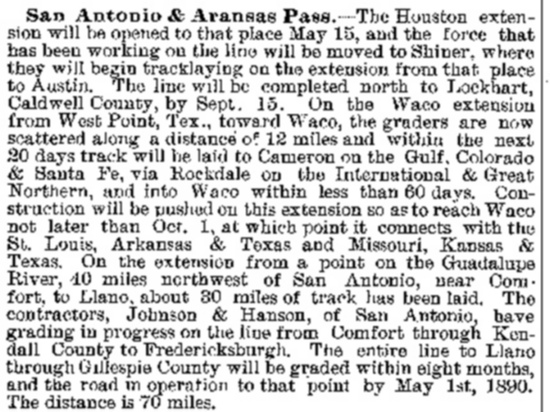 Right:
The May 17, 1889 edition of Railroad Gazette
carried this lengthy news article discussing the construction progress on
multiple lines of the SA&AP. It noted that the continuation of the route that
had reached Wallis in 1887 was expected to reach Houston by the time of
publication. The line "to Austin" would soon be in Lockhart (it reached
Lockhart, but never went farther north.) On the
Waco branch, tracks into both Rockdale and
Cameron were expected to be in place
within three weeks. The expectation "to reach Waco not later than Oct. 1" was
not fulfilled due to various delays. The final gap, between Cameron and Lott,
was held up by a lawsuit filed by a contractor for claims of unpaid grading
work. After the suit was resolved and the line completed, the
Brenham Weekly Banner
of October 29, 1891 simply reported "The gap between Cameron and Waco has been
closed."
Right:
The May 17, 1889 edition of Railroad Gazette
carried this lengthy news article discussing the construction progress on
multiple lines of the SA&AP. It noted that the continuation of the route that
had reached Wallis in 1887 was expected to reach Houston by the time of
publication. The line "to Austin" would soon be in Lockhart (it reached
Lockhart, but never went farther north.) On the
Waco branch, tracks into both Rockdale and
Cameron were expected to be in place
within three weeks. The expectation "to reach Waco not later than Oct. 1" was
not fulfilled due to various delays. The final gap, between Cameron and Lott,
was held up by a lawsuit filed by a contractor for claims of unpaid grading
work. After the suit was resolved and the line completed, the
Brenham Weekly Banner
of October 29, 1891 simply reported "The gap between Cameron and Waco has been
closed."
The article at right continues by projecting completion of the
line to Llano "by May 1st,
1890", an estimate that was off by 23 years (and even then, it stopped in Fredericksburg and did
not reach Llano.) This was to be a northward branch off the SA&AP's San Antonio
to Kerrville line that had been completed in 1887. Northwest of San Antonio "near
Comfort", work had already begun.
The
SA&AP had agreed to lay the tracks, but only if the right-of-way acquisition and roadbed construction was
handled by the Llano promoter, W. A. H. Miller. The article mentions "about 30
miles of track has been laid" which represented various disconnected track segments
that had been surveyed, graded and built. Unfortunately, the route could not
overcome the "Big Hill" between Comfort and Fredericksburg, and the effort was
ultimately abandoned. It would not be until
the fall of 1913 that the first train arrived in Fredericksburg, in the livery
of the San Antonio, Fredericksburg and
Northern Railway which had overcome the "Big Hill" with a tunnel.
For safety purposes, the Railroad Commission of Texas
(RCT) began regulating crossings of different railroads, both "at grade" and
"grade separated", under new authority granted by the Texas Legislature in 1901
("grade separated" crossings presented few safety issues, but that was the law.)
RCT issued an order dated November 8, 1901 that mandated grade crossings of two
railroad companies
be protected by gates pending further orders from RCT in which specific
crossings would be prioritized for interlocking plants and signals. At
uncontrolled crossings, state law required all
trains to stop at the diamond before proceeding. Even for crossings with a
safety gate installed and regardless of the
gate's position, all trains were still required to stop. Thus, a gate
accomplished little beyond presenting a STOP sign across the tracks to trains against which the
gate was closed, a stop they were required by law to make anyway. The regulation requiring stops at open-gate crossings
was eventually revised to allow trains to approach gated crossings at restricted
speed, slow enough to come to a complete stop if the gate was closed but
otherwise allowed to continue.
The Katy /
SA&AP crossing at West Point was likely gated relatively soon after RCT's
initial 1901 order was issued. It was not, however, prioritized for an
interlocker. RCT wanted to "spread out" the timing of interlocking tower
projects so RCT's limited engineering staff could take the time to review and
approve each plan prior to construction, and inspect and approve each
installation prior to being authorized for operations. This also served to
reduce the cash flow burden on the railroads as there were already dozens
of crossings in Texas. Railroads could, however, solicit permission from RCT to
begin the process of designing an interlocking system for a specific crossing if there was good reason to do so.
There is no evidence that the railroads requested permission from RCT for an
interlocker at West Point in the early years, nor did they have a good reason
why West Point should be prioritized. The crossing was near the town's depots,
hence most trains were stopping anyway. Moving slowly in or out of a depot meant
that an additional brief stop at the crossing created relatively little penalty
because there was no significant momentum to be lost from an energy or time
standpoint.
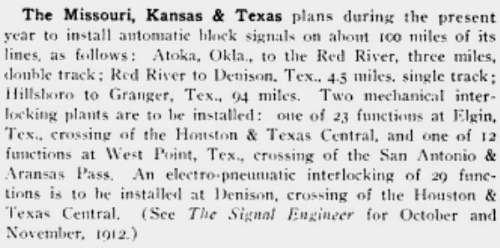 Right:
The January, 1913 issue of The Signal Engineer
identified West Point as a location for a planned interlocker installation by
the Katy. No order from RCT mandating a West Point interlocker has been found,
so this may have been simply a mutual decision of the railroads based on current
traffic levels and a desire to have through trains avoid unnecessary delays. The plan was executed and RCT's published table of active
interlockers dated October 31, 1913 showed that newly designated Tower 91 at West Point had been
commissioned for operation only twelve days earlier on October 19, 1913.
Right:
The January, 1913 issue of The Signal Engineer
identified West Point as a location for a planned interlocker installation by
the Katy. No order from RCT mandating a West Point interlocker has been found,
so this may have been simply a mutual decision of the railroads based on current
traffic levels and a desire to have through trains avoid unnecessary delays. The plan was executed and RCT's published table of active
interlockers dated October 31, 1913 showed that newly designated Tower 91 at West Point had been
commissioned for operation only twelve days earlier on October 19, 1913.
As the article projected, Tower 91 had a 12-function mechanical plant, a basic
design for a crossing of two railroads consisting of a home signal, distant
signal and derail in each of the four directions. It was likely a two-story
tower, but no photos of it have been found. The article attributed the
plan to the Katy, so it is unsurprising that
RCT records show the tower staffed and maintained by Katy personnel. Under RCT's rules, the
capital outlay for the tower and its interlocking system would have been shared
equally by the two railroads because the crossing existed prior to 1901 when regulatory authority for crossings was granted to RCT. Operating and
maintenance expenses would have been split evenly between the two railroads
because they each accounted for half of the interlocker functions.
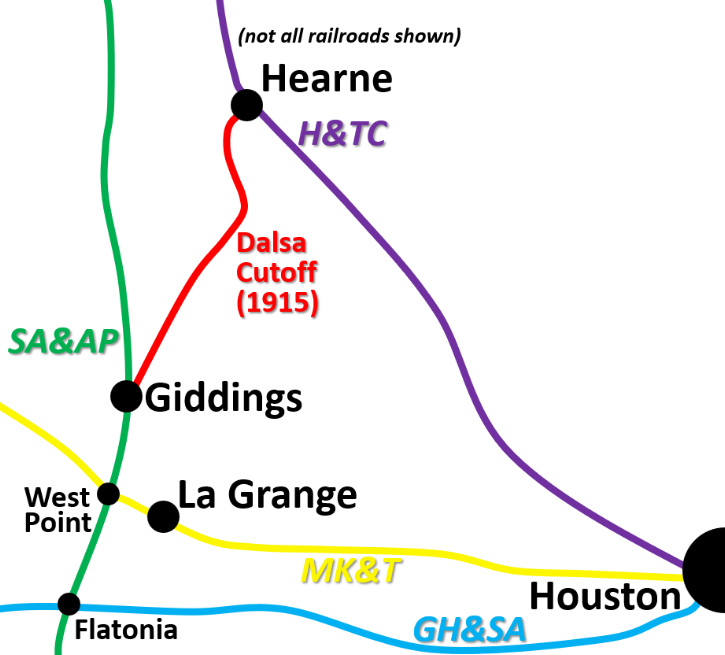 The
decision by the railroads to install an interlocker at West Point seems prescient
in retrospect; the
traffic through West Point increased substantially two years later when Southern
Pacific (SP) opened the Dalsa Cutoff between Giddings and
Hearne. SP owned the
Houston & Texas Central (H&TC) Railway which went north to
Dallas and Fort
Worth, and it owned the Galveston, Harrisburg & San Antonio (GH&SA) Railway
which went west to San Antonio,
El Paso and Los Angeles. SP
traffic between points west on the GH&SA and points north on the H&TC had to
pass through Houston, where rail congestion added
significant delay. In 1915, SP opened the Dalsa Cutoff using trackage rights on
the SA&AP between Giddings and Flatonia
(the rights were officially held by the H&TC). The Cutoff saved
valuable time for traffic that could bypass Houston, and geographically, the new
route was considerably shorter between Dallas and San Antonio (hence, the "Dal-SA"
name.) Tower 91 was operational almost a year and half before the Cutoff opened,
but whether this was excellent planning or simple luck is undetermined.
Depending on when SP initiated trackage rights
discussions with the SA&AP, it is certainly possible that the interlocker
was installed in anticipation of the traffic increase that the Cutoff
would bring.
The
decision by the railroads to install an interlocker at West Point seems prescient
in retrospect; the
traffic through West Point increased substantially two years later when Southern
Pacific (SP) opened the Dalsa Cutoff between Giddings and
Hearne. SP owned the
Houston & Texas Central (H&TC) Railway which went north to
Dallas and Fort
Worth, and it owned the Galveston, Harrisburg & San Antonio (GH&SA) Railway
which went west to San Antonio,
El Paso and Los Angeles. SP
traffic between points west on the GH&SA and points north on the H&TC had to
pass through Houston, where rail congestion added
significant delay. In 1915, SP opened the Dalsa Cutoff using trackage rights on
the SA&AP between Giddings and Flatonia
(the rights were officially held by the H&TC). The Cutoff saved
valuable time for traffic that could bypass Houston, and geographically, the new
route was considerably shorter between Dallas and San Antonio (hence, the "Dal-SA"
name.) Tower 91 was operational almost a year and half before the Cutoff opened,
but whether this was excellent planning or simple luck is undetermined.
Depending on when SP initiated trackage rights
discussions with the SA&AP, it is certainly possible that the interlocker
was installed in anticipation of the traffic increase that the Cutoff
would bring.
Below:
The San Antonio Express of Thursday, March 4,
1915 carried this news item reporting that the first train to operate over the Dalsa
Cutoff had run the prior Sunday, which was February 28, 1915.
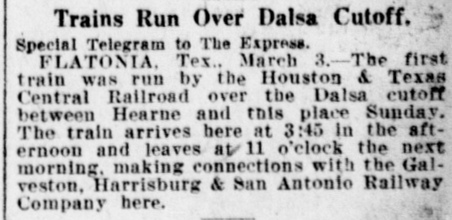
SP's association with the SA&AP dated back to 1892.
When the SA&AP came out of receivership, SP was allowed to buy it and make the
SA&AP a wholly-owned subsidiary. This worked well for both railroads until the
State of Texas filed a lawsuit in 1903 to demand divestiture of the SA&AP,
supposedly for anti-competitive ownership. The state's argument was that the
SA&AP and other SP railroads had too many parallel routes which tended to
suppress competition, a violation of state law. The routes had been in place at
the outset, eleven years earlier, but the state had not taken action; the issue
hadn't even been raised. SP Chairman, E. H. Harriman, saw the invisible
fingerprints of B. F. Yoakum behind the lawsuit. Yoakum, a native Texan,
certainly had close
relationships with the RCT Commissioners, and it was RCT that had requested the
lawsuit by the Texas Attorney General. Yoakum held a powerful position, Chairman of the
Frisco, but why would he want to advance such a ploy?
Yoakum had just
begun to execute his long-term plan to compete with SP for Gulf Coast traffic
between New Orleans and Brownsville, centered on Houston. He had just chartered
the aforementioned SLB&M (with Lott as President, the first component of the
Frisco's eventual Gulf Coast Lines consortium) to build into the Rio Grande Valley to connect it with the national
rail network (although Laredo was connected, the agricultural heart of the
Valley...Brownsville, Harlingen, McAllen...was not.) Yoakum knew that the SA&AP
backed by its parent company SP had begun building toward
the Valley from Alice, its southernmost service point. SA&AP's line into Alice
was being extended south to Falfurrias, and the heart of the Valley at McAllen
was only 73 miles farther south. Disrupting the
SA&AP's construction would enable Yoakum to get to the Valley first. There
was no direct evidence that Yoakum had encouraged RCT to initiate the lawsuit,
but Harriman was convinced (and he must have been particularly galled by the
thought; when SP acquired the SA&AP out of bankruptcy in 1892, Yoakum had been
the court-appointed Receiver, yet the acquisition had been accepted by the Court
without objection, and Yoakum had apparently said nary a word.)
When the State of Texas won the
lawsuit, the court ordered SP to divest the SA&AP and guarantee SA&AP bonds that
had been issued during SP ownership. This created financial uncertainty for the
newly independent SA≈ selling new bonds to finance the remaining construction
to the Rio Grande Valley would be difficult. The SA&AP did complete the 36 miles
to Falfurrias in 1904, but they went no farther. Meanwhile, Yoakum's SLB&M
started construction at Robstown and had a line in
operation between Brownsville and Houston by 1908.
SP was ultimately able to reacquire the SA&AP in 1925 and restart construction
south from Falfurrias. Their tracks finally reached the Valley at
Edinburg and McAllen in 1927. In 1934, SP
consolidated most of its Texas and Louisiana railroads, including the SA&AP,
into a single operating entity, the Texas & New Orleans (T&NO) Railroad. At that
point, the SA&AP ceased to exist and ownership of its lines was transferred
to the T&NO.
In 1915, the Katy went into bankruptcy and was subsequently operated by a
court-appointed Receiver. In April, 1923, the bankruptcy ended and the newly
constituted company was known as the Missouri - Kansas - Texas Railroad, giving
rise to a new abbreviation, "M-K-T" or simply "MKT", replacing "MK&T". But
everyone still called it the Katy.
 |
Left: A 1940
T&NO employee timetable shows Tower 91 having "Continuous" staffed
hours, and lists these Whistle Codes for trains to signal the towerman
to line specific movements. The January 28, 1928 issue of
Railway Signaling had reported four
additional levers added to the Tower 91 plant. These levers might have
been for tower-controlled signals and switches for the siding. RCT's
final comprehensive interlocker report published at the end of 1930
listed a total of twenty functions for Tower 91. |
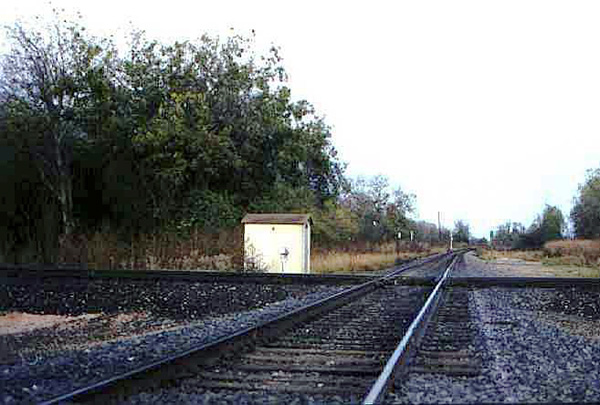

Above Left: This photo (Jim
King, c.1999) facing east along the former Katy tracks shows the equipment cabin
that housed the automatic interlocking plant at West Point after the Tower 91
manned structure was retired. The cabin is sitting in the northeast quadrant of
the crossing, the historic location of the manned tower. The date of the tower's
retirement remains to be determined. A 1959 T&NO employee timetable reports the Tower 91
crossing as an automatic interlocking which could easily have been in place well before that time.
Above Right: With North to the
right, this track chart (courtesy, Stuart Schroeder) for West Point dated
December 12, 1924 shows connecting tracks in both of the eastern quadrants of
the diamond. The rectangle immediately northeast of the diamond is labeled "Intlr.
Tower", apparently an abbreviation for "Interlocker Tower", i.e. Tower 91.
Below: This undated photo
(Chino Chapa collection) shows a passenger train at the Katy depot. The view is
to the west and the train is headed for Smithville. Bruce Blaylock notes that
"...there are teams and buggies but no automobiles, so I'm thinking this would
be around 1900." A smaller Katy depot that presumably replaced this one is
reported to have been relocated to the Smithville Railroad Park, refurbished and
relabeled as Smithville's Katy depot.
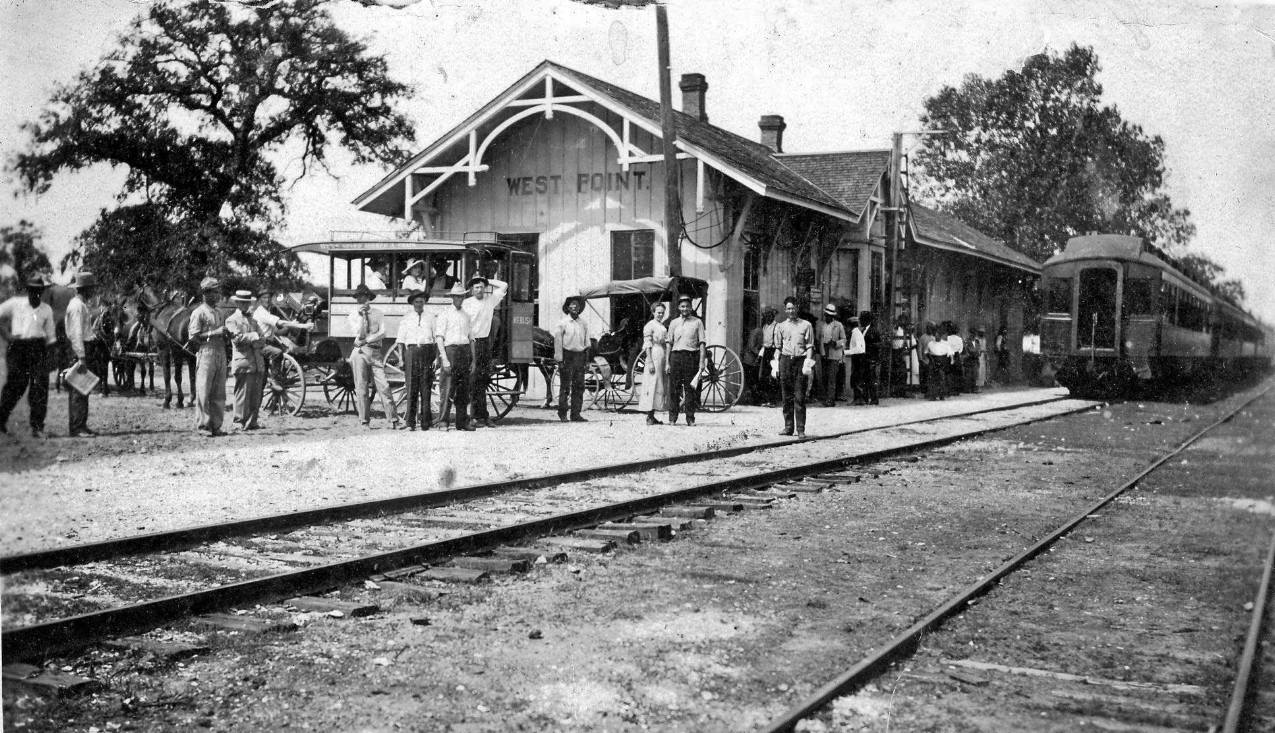
Right: This 1915 track chart (courtesy, Ed
Chambers) shows the relative locations of the two stations at West
Point, and indicates that the connecting tracks present in the 1924
track chart were already in place by 1915.
Below: undated photo of the Katy depot (William Wessels collection)
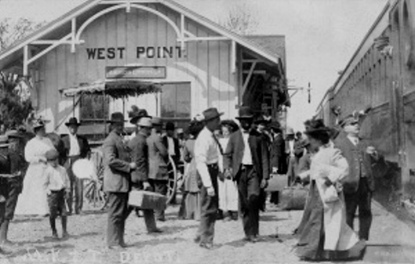
During World War I when railroads were governed by the U. S.
Railroad Administration (USRA), the two railroads at West Point applied
to RCT for permission to build a joint station, noting that the USRA
district director concurred with their request. RCT granted the
application, but no evidence has surfaced to indicate that a Union
Station at West Point was actually built. |
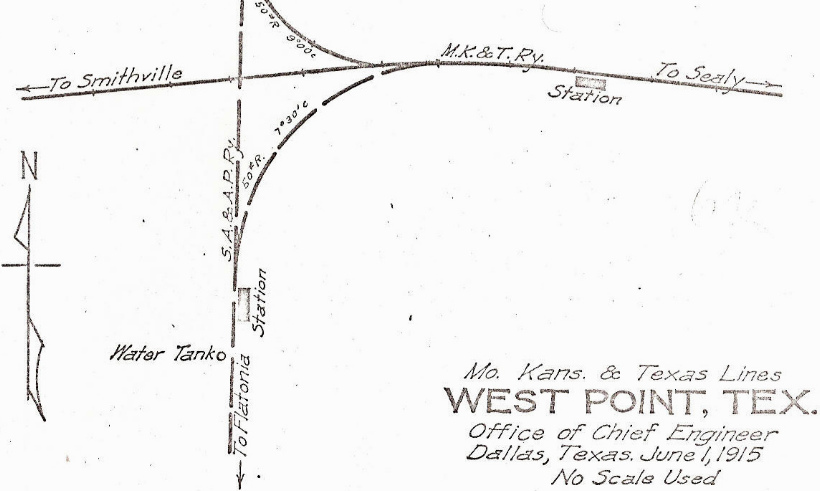 |
Below: This undated map of
the West Point crossing (Stuart Schroeder collection) shows both depots along
with a Tool House, Section House, Cotton Platform and SA&AP turntable. It does
not show Tower 91.

Union Pacific (UP) acquired MP in 1982, but MP
continued to operate under its own name. UP then acquired the Katy in 1988,
merging it into MP. In 1996, SP was acquired and merged into UP, and the
following year, MP was fully merged into UP. Hence, both
tracks at the West Point crossing are owned and operated by UP. The former Katy
line remains active in both directions, although it no longer continues all the
way to Houston, terminating 22 miles east of Sealy in the town of Katy. The Dalsa Cutoff
remains very active through West Point, but the T&NO tracks north of Giddings
(to Cameron) were abandoned in 1959. The tracks between Cameron and Waco were subsequently abandoned except for
industrial tracks retained near Cameron. To the south, the former SA&AP tracks are fully intact to the
original branch point at Yoakum, and they continue south to Cuero on SA&AP
heritage rails.
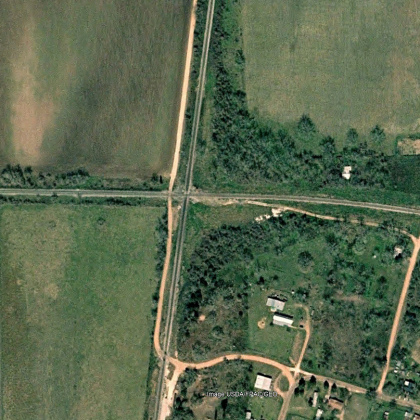
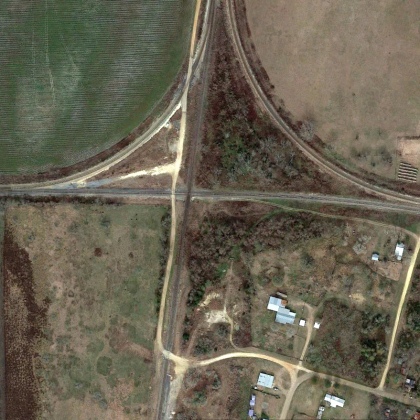
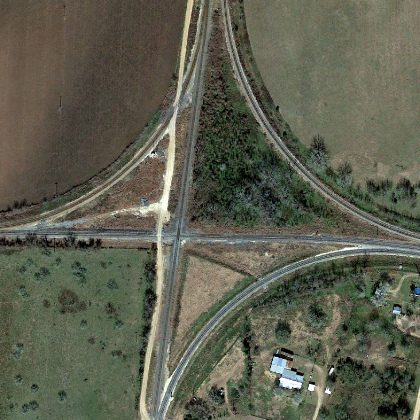
Above: The
presence of connecting tracks at West Point has changed considerably in recent
years, no doubt a manifestation of UP's ownership of both main lines. These Google Earth
satellite images (left to right,
2001, 2018 and 2022) show the gradual addition of connectors in three of the
four quadrants. The 2001 image shows that by then, the previous connecting
tracks depicted on the early track charts had been removed long enough to give
very little evidence that they had ever existed. Historic aerial imagery
suggests that those tracks had been removed by 1974 and likely earlier.
New connectors in the two north quadrants were in place by 2018, and a connector
in the southeast quadrant was added between 2018 and 2022.
Below Left: These Google Street View
images from May, 2011 show rail cars on the northeast quadrant connector, which
obviously dated back to at least that year. The
sign on the equipment cabin identifies the connector as "LCRA Jct", suggesting that
the movement of coal trains to and from the Lower
Colorado River Authority (LCRA) coal-fired power plant seven miles east
of La Grange was the impetus for building it. Below Right: In
this closer view of the railcars, the West Point crossing diamond is barely
visible in the distance.
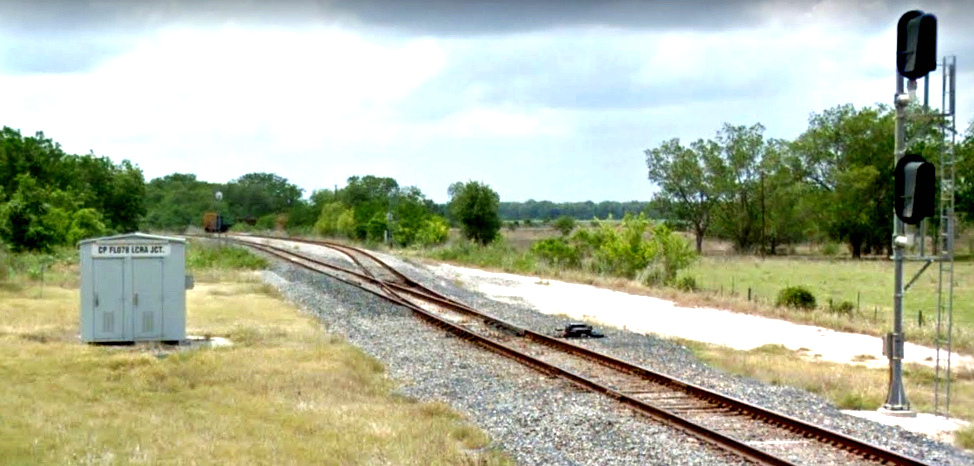
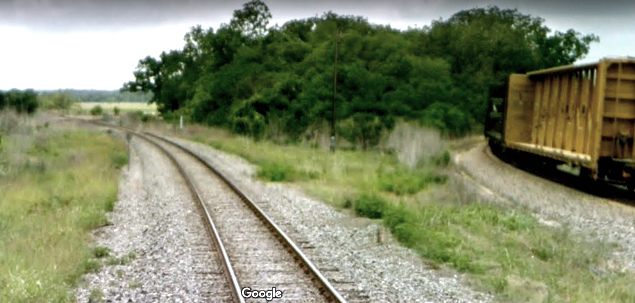








 The
decision by the railroads to install an interlocker at West Point seems prescient
in retrospect; the
traffic through West Point increased substantially two years later when Southern
Pacific (SP) opened the Dalsa Cutoff between Giddings and
The
decision by the railroads to install an interlocker at West Point seems prescient
in retrospect; the
traffic through West Point increased substantially two years later when Southern
Pacific (SP) opened the Dalsa Cutoff between Giddings and












